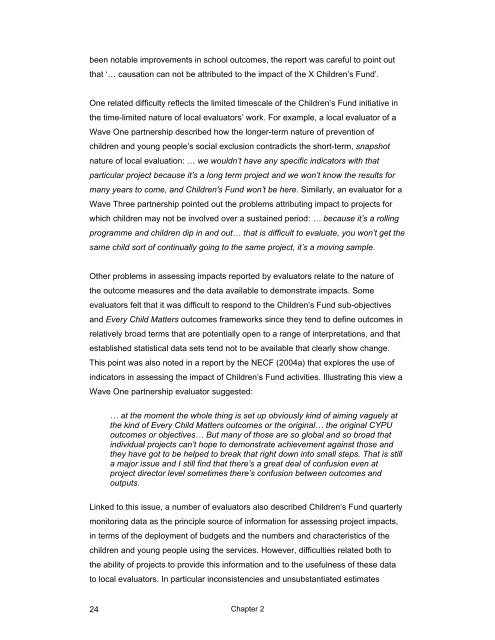Local Evaluation of Children's Services Learning from the Children's ...
Local Evaluation of Children's Services Learning from the Children's ...
Local Evaluation of Children's Services Learning from the Children's ...
- No tags were found...
You also want an ePaper? Increase the reach of your titles
YUMPU automatically turns print PDFs into web optimized ePapers that Google loves.
een notable improvements in school outcomes, <strong>the</strong> report was careful to point outthat ‘… causation can not be attributed to <strong>the</strong> impact <strong>of</strong> <strong>the</strong> X Children’s Fund’.One related difficulty reflects <strong>the</strong> limited timescale <strong>of</strong> <strong>the</strong> Children’s Fund initiative in<strong>the</strong> time-limited nature <strong>of</strong> local evaluators’ work. For example, a local evaluator <strong>of</strong> aWave One partnership described how <strong>the</strong> longer-term nature <strong>of</strong> prevention <strong>of</strong>children and young people’s social exclusion contradicts <strong>the</strong> short-term, snapshotnature <strong>of</strong> local evaluation: … we wouldn’t have any specific indicators with thatparticular project because it’s a long term project and we won’t know <strong>the</strong> results formany years to come, and <strong>Children's</strong> Fund won’t be here. Similarly, an evaluator for aWave Three partnership pointed out <strong>the</strong> problems attributing impact to projects forwhich children may not be involved over a sustained period: … because it’s a rollingprogramme and children dip in and out… that is difficult to evaluate, you won’t get <strong>the</strong>same child sort <strong>of</strong> continually going to <strong>the</strong> same project, it’s a moving sample.O<strong>the</strong>r problems in assessing impacts reported by evaluators relate to <strong>the</strong> nature <strong>of</strong><strong>the</strong> outcome measures and <strong>the</strong> data available to demonstrate impacts. Someevaluators felt that it was difficult to respond to <strong>the</strong> Children’s Fund sub-objectivesand Every Child Matters outcomes frameworks since <strong>the</strong>y tend to define outcomes inrelatively broad terms that are potentially open to a range <strong>of</strong> interpretations, and thatestablished statistical data sets tend not to be available that clearly show change.This point was also noted in a report by <strong>the</strong> NECF (2004a) that explores <strong>the</strong> use <strong>of</strong>indicators in assessing <strong>the</strong> impact <strong>of</strong> Children’s Fund activities. Illustrating this view aWave One partnership evaluator suggested:… at <strong>the</strong> moment <strong>the</strong> whole thing is set up obviously kind <strong>of</strong> aiming vaguely at<strong>the</strong> kind <strong>of</strong> Every Child Matters outcomes or <strong>the</strong> original… <strong>the</strong> original CYPUoutcomes or objectives… But many <strong>of</strong> those are so global and so broad thatindividual projects can’t hope to demonstrate achievement against those and<strong>the</strong>y have got to be helped to break that right down into small steps. That is stilla major issue and I still find that <strong>the</strong>re’s a great deal <strong>of</strong> confusion even atproject director level sometimes <strong>the</strong>re’s confusion between outcomes andoutputs.Linked to this issue, a number <strong>of</strong> evaluators also described Children’s Fund quarterlymonitoring data as <strong>the</strong> principle source <strong>of</strong> information for assessing project impacts,in terms <strong>of</strong> <strong>the</strong> deployment <strong>of</strong> budgets and <strong>the</strong> numbers and characteristics <strong>of</strong> <strong>the</strong>children and young people using <strong>the</strong> services. However, difficulties related both to<strong>the</strong> ability <strong>of</strong> projects to provide this information and to <strong>the</strong> usefulness <strong>of</strong> <strong>the</strong>se datato local evaluators. In particular inconsistencies and unsubstantiated estimates24Chapter 2
















